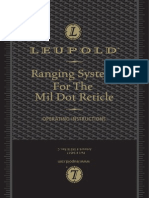Mil Dot Explained
Mil Dot Explained
Uploaded by
mazternetCopyright:
Available Formats
Mil Dot Explained
Mil Dot Explained
Uploaded by
mazternetOriginal Description:
Copyright
Available Formats
Share this document
Did you find this document useful?
Is this content inappropriate?
Copyright:
Available Formats
Mil Dot Explained
Mil Dot Explained
Uploaded by
mazternetCopyright:
Available Formats
Mil-Dot Explained
If you have spent many sleepless nights wondering what those little dots are for on a military rifle scope's reticle, then look no further. This should explain, in a (somewhat) clear and concise fashion, how the mil-dot reticle works and also what "minute-of-angle" means. Minute-Of-Angle The term "minute-of-angle" (MOA) is used regularly by target shooters at the range, but is probably understood, thoroughly, by few (the same goes for mil-dots). Defined loosely, one MOA = 1" @ 100 yards; so, if you shot your rifle 5 times into a 100-yard target and every shot went into a one-inch circle you had drawn on the paper, then your rifle could be said to shoot 1 MOA. Likewise, if every shot goes into a two-inch circle at 200 yards, then you're shooting 1 MOA. A 10-inch group at 500 yards would be 2 MOA. Now we get to the fun part. If you are not a math whiz, dont worry. Ok, there are 360 degrees in a circle. Each degree can be broken down further into minutes. There are 60 minutes in a degree. Likewise, there are 60 seconds in a minute. Now, to figure out the distance subtended by 1 minute at any particular distance, we need merely to plug those two values into a simple trigonometric equation. The tangent function fits the bill nicely. Here's the equation: tan(angle) = distance subtended(to extend under or be opposite to )/distance to the target (units must be consistent--e.g., 1/36 of a yard [1"] divided by 100 yards) Ok, now we know the angle (1 minute or 1/60 of a degree) and we know the distance to the target (100 yards), but we need to figure out the actual distance subtended at the target - i.e., is 1 MOA actually 1" @ 100 yards? What we need to do is solve for "distance subtended." Here's our final equation: tan(angle)*distance to the target = distance subtended Make sure your calculator is in "degree" mode (as opposed to "radian" or "gradian") and type in 1/60 (for degrees) and hit the "tangent" button. Then multiply that by 100 yards. This should give you the distance (in yards) subtended at 100 yards. Multiply this by 36 to get inches. The answer should be: 1.047197580733" This is just a hair over the commonly quoted "one inch". At 1000 yards, this would be almost 10 1/2 inches. As turns out it is just a coincidence that 1 MOA happens to be close to 1" @ 100 yards. It is, however, very convenient.
www.ShootistArmsCompany.com 888-594-8789 817-599-6767 Page 1 of 3
The Mil-Dot By the way, "Mil" in "Mil-Dot" does not stand for "Military"; it stands for "milliradian." The radian is a unit less measure which is equivalent, in use, to degrees. It tells you how far around a circle you have gone. 2 (pi) radians = 360 degrees. Using 3.14 as the value of (pi), 6.28 radians take you all the way around a circle. Using the Cartesian coordinate system, you can use "x"- and "y"-values to define any point on the plane. Radians are used in a coordinate system called "polar coordinates." A point on the plane is defined, in the polar coordinate system, using the radian and the radius. The radian defines the amount of rotation and the radius gives the distance from the origin (in a negative or positive direction). The radian is another measurement of rotation (the degree/minute/second-system being the first). This is the system used in the mil-dot reticle. We use the same equation that we used before, but instead of your calculator being in "degree" mode, switch it to "radian" mode. One milliradian = 1/1000 (.001) radians. So, type .001 into your calculator and hit the "tangent" button. Then multiply this by "distance to the target." Finally, multiply this by 36 to get inches subtended at the given distance. With the calculator in "radian" mode, type: tangent(.001)*100*36 = 3.6000012" One milliradian is just over 3.6 inches at 100 yards. If we extrapolate this out, two milliradians is equal to about 6 feet at one-thousand yards. The importance of this will come up below. The Mil-Dot Reticle The mil-dot reticle was designed around the measurement unit of the milliradian. The dots, themselves, were designed with this in mind and the spacing of the dots was also based upon the milliradian. This allows the shooter to calculate the distance to an object of known height or width. Height of the target in yards divided by the height of the target in milliradians multiplied by 1000 equals the distance to the target in yards. For example, take a 6foot-tall man (2 yards). Let's say that the top of his head lines up with one dot and his feet line up four dots down. So: (2/4)*1000 = 500 yards away. This same technique can be used to estimate lead on a moving target or to compensate for deflection on a windy day.
www.ShootistArmsCompany.com 888-594-8789 817-599-6767 Page 2 of 3
The distance from the center of one dot to the center of the next dot is 1 milliradian. We are told that the length of a dot is 1/4 milliradian or 3/4 MOA. (Given this much information, one can determine that the distance between dots is 3/4 milliradian). * Note: we use the term "length" because the mil-dot is not round. It is oblong. The "dots" on the vertical crosshair run oblong in the vertical direction. The dots on the horizontal crosshair run oblong in the horizontal direction (i.e., they are lying on their sides). The width of each dot is an arbitrary distance and is not used for any practical purpose. Like a duplex reticle, the mil-dot reticle is thicker towards the edges and uses thin lines in the middle where the dots are located and the crosshairs cross. The distance between the opposite thick portions is 10 milliradians. *NOTE: 1/4 milliradian = .9" and 3/4 MOA = .785", so, obviously a mil-dot cannot be both 1/4 milliradian and 3/4 MOA. The dots on most mil-dot reticles are 1/4 mil. They are not 3/4 MOA. To summarize: To use a mil-dot reticle effectively, all one need remember is that the distance between the dot centers is 36" at 1000 yards. This lets you determine the range of a target of known size. At that point, you can dial the scope in for proper elevation OR use the dots to hold over the proper amount. The dots on the horizontal crosshair can be used to lead a target (if you know the range to the target, then you'll know the distance between dots, and thus the distance to lead) or to compensate for deflection. I have personally found that the use of the Mil-dot Master was the best analog computer for making these calculations. Check this out @ http://www.mildot.com/testdrive.htm So now here is all you ever wanted to know about mil-dots and minutes-of-angle, and then some! Or you can just buy a fancy1000m range finder and hope you never run out of batteries in the field.
www.ShootistArmsCompany.com 888-594-8789 817-599-6767 Page 3 of 3
You might also like
- Watchtower: Reference For "Fully Accomplish Your Ministry", 2014Document209 pagesWatchtower: Reference For "Fully Accomplish Your Ministry", 2014sirjsslut100% (9)
- User Guide Mil Dot Mira TelescopicaDocument6 pagesUser Guide Mil Dot Mira TelescopicaDavid AreasNo ratings yet
- Horus Reticle ManDocument28 pagesHorus Reticle ManKaterina DimitriouNo ratings yet
- Mil Dots & MOADocument2 pagesMil Dots & MOAAnonymous mcJZ1wVX89No ratings yet
- Sniper FormulasDocument6 pagesSniper Formulashaji5100% (1)
- Leupold Tactical Milling Reticle ManualDocument36 pagesLeupold Tactical Milling Reticle ManualAmmoLand Shooting Sports News100% (2)
- Maximizing The Mil Reticle (Shooting Voodoo)Document9 pagesMaximizing The Mil Reticle (Shooting Voodoo)Ivan100% (2)
- Mils and Moa: A Shooters Guide To Understanding: - Mils - Minute of Angle (Moa) - The Range Estimation EquationsDocument22 pagesMils and Moa: A Shooters Guide To Understanding: - Mils - Minute of Angle (Moa) - The Range Estimation EquationsRob90100% (1)
- Mils and Moa SimplifiedDocument9 pagesMils and Moa SimplifiedBob Simeone100% (13)
- Mill DotDocument3 pagesMill DotdestonhensonNo ratings yet
- Ranging System For The Mil Dot Reticle: Operating InstructionsDocument30 pagesRanging System For The Mil Dot Reticle: Operating InstructionsBruno López100% (1)
- Mil and MOA ConversionsDocument2 pagesMil and MOA ConversionsrcNo ratings yet
- Reticle Guide Brochure 6-23.16Document20 pagesReticle Guide Brochure 6-23.16akms1982100% (1)
- Horus Vision ASLIDocument4 pagesHorus Vision ASLITwobirds Flying PublicationsNo ratings yet
- 18 - Zero Data MGM PDFDocument1 page18 - Zero Data MGM PDFthNo ratings yet
- Shooting in The WindDocument7 pagesShooting in The WindjunkrikaNo ratings yet
- 16 - Zero Data IPSC PDFDocument1 page16 - Zero Data IPSC PDFthNo ratings yet
- Field Craft EssentialsDocument24 pagesField Craft EssentialsmarvNo ratings yet
- Mildot GuideDocument19 pagesMildot Guidetalyw77100% (1)
- 12 Mil2Yards 1 PDFDocument1 page12 Mil2Yards 1 PDFthNo ratings yet
- Swat 2019Document83 pagesSwat 2019Mario AraujoNo ratings yet
- MPH Estimates TOF Estimates: Movers Human TargetDocument1 pageMPH Estimates TOF Estimates: Movers Human TargetthNo ratings yet
- 5 - Formula TMR PDFDocument1 page5 - Formula TMR PDFthNo ratings yet
- SniperDocument4 pagesSniperantoniofuentesjrNo ratings yet
- 3 - Formula GEN2 PDFDocument1 page3 - Formula GEN2 PDFthNo ratings yet
- 24 - Grid Bullseye Target PDFDocument1 page24 - Grid Bullseye Target PDFth100% (1)
- User Manual AimpointML2Document6 pagesUser Manual AimpointML264ssqax7100% (1)
- Bright Hazy Overcast Changing Light (3) Med (7) Heavy (15) - 100 Y / M 200 Y / M 300 Y / M - Y / MDocument1 pageBright Hazy Overcast Changing Light (3) Med (7) Heavy (15) - 100 Y / M 200 Y / M 300 Y / M - Y / MthNo ratings yet
- 14 - Geo Shooting Card PDFDocument1 page14 - Geo Shooting Card PDFthNo ratings yet
- 23 - Simple Bullseye Target PDFDocument1 page23 - Simple Bullseye Target PDFthNo ratings yet
- 5.56x45 M855A1Document11 pages5.56x45 M855A1Anonymous jIzz7woS6100% (1)
- HK Precision Marksman IDocument116 pagesHK Precision Marksman IMatthew NelsonNo ratings yet
- Zen of The 100 Meter ZeroDocument4 pagesZen of The 100 Meter Zero6462dan100% (1)
- F Class Target Shooting Techniques Level 1 ForwardDocument33 pagesF Class Target Shooting Techniques Level 1 ForwardCKNo ratings yet
- Basic Photography Equipment - From The "Crime Scene and Evidence Photographer's Guide"Document2 pagesBasic Photography Equipment - From The "Crime Scene and Evidence Photographer's Guide"Mark100% (1)
- Ballistic Plex ReticleDocument4 pagesBallistic Plex ReticleM118LR100% (1)
- Formulas: Target SZ Inches X 27.78 Yards Mil Reading of TargetDocument1 pageFormulas: Target SZ Inches X 27.78 Yards Mil Reading of TargetthNo ratings yet
- The Angle Cosine Indicator by Hugo TeufelDocument3 pagesThe Angle Cosine Indicator by Hugo TeufelsrahhalNo ratings yet
- Army Rifle Zeroing GuideDocument25 pagesArmy Rifle Zeroing GuidehaysouseNo ratings yet
- Sniper Positions 7 PagesDocument7 pagesSniper Positions 7 PagesSteven100% (1)
- The Platoon Leader's Guide To IPBDocument3 pagesThe Platoon Leader's Guide To IPBsheng cao100% (1)
- 6-2. Rifle Squad TacticsDocument19 pages6-2. Rifle Squad Tacticsrewof237250% (2)
- 3 SOTIC Memorandum of InstructionDocument6 pages3 SOTIC Memorandum of InstructionOLSNo ratings yet
- Basic Surveillance Operations Flyer 3 DayDocument2 pagesBasic Surveillance Operations Flyer 3 Dayriseabove23100% (1)
- Combat Formations - Lesson PlanDocument18 pagesCombat Formations - Lesson Plankrayzkjun100% (1)
- Instructor Syllabus - Cold Weather CarbineDocument11 pagesInstructor Syllabus - Cold Weather CarbineCole MotzNo ratings yet
- 19 - Load Data PDFDocument1 page19 - Load Data PDFthNo ratings yet
- Weapons Tactics Strategy Airsoft Guns Machine Pistols Sniper Rifles AlternativeDocument10 pagesWeapons Tactics Strategy Airsoft Guns Machine Pistols Sniper Rifles AlternativeAndré Luiz Zavariz MadeiraNo ratings yet
- Ta31f Acog Training.344110115Document50 pagesTa31f Acog Training.344110115Chelsea McAuley100% (2)
- 071-329-1002 Determine Grid CordinatesDocument5 pages071-329-1002 Determine Grid CordinatesMYEMAIL6306No ratings yet
- FoldAR Operator's Manual Rev1.0Document42 pagesFoldAR Operator's Manual Rev1.0qasssdewNo ratings yet
- Red Dots ManualDocument16 pagesRed Dots ManualRajesh S BhattNo ratings yet
- User Guide For Mil Dot Equipped OpticsDocument14 pagesUser Guide For Mil Dot Equipped OpticsPatryk Stencel100% (1)
- How to Operate Your Rifle Like a Pro: U.S. Army Official Manual, With Demonstrative ImagesFrom EverandHow to Operate Your Rifle Like a Pro: U.S. Army Official Manual, With Demonstrative ImagesNo ratings yet
- Regulations for the Order and Discipline of the Troops of the United StatesFrom EverandRegulations for the Order and Discipline of the Troops of the United StatesNo ratings yet
- Mils and MOA A Tactical Shooters GuideDocument46 pagesMils and MOA A Tactical Shooters GuideBob Simeone95% (20)
- MOA vs MRAD? MILSDocument6 pagesMOA vs MRAD? MILSiqbal bagoes 98No ratings yet
- Minute of ArcDocument4 pagesMinute of ArcvnfloreaNo ratings yet
- Mils / MOA: A Basic Study For ShootersDocument32 pagesMils / MOA: A Basic Study For ShootersBob Simeone100% (8)
- Econ 102 Man DalDocument6 pagesEcon 102 Man Dalam7528No ratings yet
- Team Name: - Group Presentation Rubric Trait Criteria PointsDocument1 pageTeam Name: - Group Presentation Rubric Trait Criteria PointsJenn PacanzaNo ratings yet
- God of Small Things: Daughters of Penelope Foundation Book Club Discussion QuestionsDocument2 pagesGod of Small Things: Daughters of Penelope Foundation Book Club Discussion QuestionsChristopher HintonNo ratings yet
- Philosophy of Mind - PRACTICUMDocument37 pagesPhilosophy of Mind - PRACTICUMJerone Pavel Cruz100% (1)
- Ripley's Twelve GatesDocument2 pagesRipley's Twelve GatesAnn H ZapizNo ratings yet
- Created by Kuya Meccs: Ethics Quiz 1 90/100Document25 pagesCreated by Kuya Meccs: Ethics Quiz 1 90/100Kenny Stephen Cruz100% (2)
- AURO University: Module Leader: DR Rohit SinghDocument31 pagesAURO University: Module Leader: DR Rohit SinghDisha SarawagiNo ratings yet
- Bibliography EditedDocument4 pagesBibliography EditedJesse John A. CorpuzNo ratings yet
- 08 - Chapter 1 PDFDocument12 pages08 - Chapter 1 PDFPallavi PradhanNo ratings yet
- Activity Sheet 1Document6 pagesActivity Sheet 1chrisNo ratings yet
- MC Elt 8 and MC ResDocument19 pagesMC Elt 8 and MC ResJhari May PalmaNo ratings yet
- Report Writing TemplateDocument11 pagesReport Writing TemplateKirz SerranoNo ratings yet
- Essay Outline WorksheetDocument2 pagesEssay Outline WorksheetRabeeaManzoorNo ratings yet
- Sample Pheno MethodologyDocument6 pagesSample Pheno Methodologynoronisa talusobNo ratings yet
- 122.22 The Pentateuch - Syllabus - Fall 2011Document15 pages122.22 The Pentateuch - Syllabus - Fall 2011Noremacm100% (2)
- 1887 - 2718709-Article - Letter To EditorDocument18 pages1887 - 2718709-Article - Letter To EditorCesar MullerNo ratings yet
- Instructional Supervision Power Point-1Document17 pagesInstructional Supervision Power Point-1kavitha0909100% (1)
- Assessment and Evaluation DefinedDocument18 pagesAssessment and Evaluation DefinedSheryl CaturaNo ratings yet
- Disagree Agreeably PM V3Document6 pagesDisagree Agreeably PM V3Ayram Texidor100% (1)
- Legal WritingDocument3 pagesLegal WritingAnonymous FQTgjfNo ratings yet
- Introduction To Western PhilosophyDocument5 pagesIntroduction To Western PhilosophyjayNo ratings yet
- English 10 - Week 4 - Module 4Document6 pagesEnglish 10 - Week 4 - Module 4jp marceloNo ratings yet
- Chapter-10 Return & RiskDocument19 pagesChapter-10 Return & Riskaparajita promaNo ratings yet
- Research 2 LinazaDocument14 pagesResearch 2 LinazaMae UmeNo ratings yet
- Session-2 Introduction To Sets, Types of Sets and Operations On SetsDocument31 pagesSession-2 Introduction To Sets, Types of Sets and Operations On SetsNalam AshikaNo ratings yet
- Q2e RW4 U08 OutlineDocument2 pagesQ2e RW4 U08 OutlinehuyNo ratings yet
- Definition of Terms: Danilo V. Rogayan JRDocument10 pagesDefinition of Terms: Danilo V. Rogayan JRJon AizaNo ratings yet
- Govindan and ShankarDocument9 pagesGovindan and ShankarWacko AsahanNo ratings yet
- BILLIONDocument1 pageBILLIONRoy C. EstenzoNo ratings yet

























































































